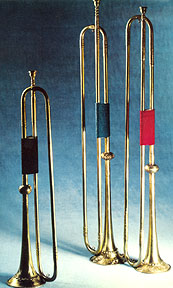The trumpet actually changed little from the Renaissance into the baroque. Perhaps the most obvious difference was an increase in the flare of the bell, creating a louder, brighter tone. Besides the absence of valves, the biggest difference between the modern trumpet and the baroque trumpet is the length: baroque trumpets are basically twice as long as modern trumpets. They often play in the same range but the baroque trumpet is much higher in its harmonic series when playing the same notes.

Trumpet with its range and a transposing mute, from Harmonie Universelle (Paris, 1636) by Marin Mersenne.
Baroque trumpet with orchestra. Concerto in D major, 2nd mvt. (excerpt) by George Philipp Telemann, performed by Niklas Eklund with the Drottningholm Baroque Ensemble directed by Nils-Erik Sparf. Naxos 553531 (1996). Trk 2
Trumpets continued to be used for fanfares through the baroque era. They also developed a repertoire of ensemble music which involved specialzation into different registers: principale and clarino, where principale is the common register of arpeggios for fanfares, and clarino is the stepwise high register for the playing of melodies. This is the register that was exploited for such famous solos as Bach’s Brandenburg Concerto No. 2.

Three Nuremberg trumpets. In F or G by Johann Wilhelm Haas, in D by Johann Leonhard Ehe (1638-1707) and in D (1693) by Johann Karl Lodisch (1654-1721). Brussels, Musée Instrumental 1176, 1177, & 1180.
Baroque trumpet with orchestra. Cantata 66, Erfreut euch, ihr Herzen, 1st mvt. (excerpt) by J. S. Bach, performed by Don Smithers with the Leanhardt Consort. Teldec 8.35335 (1988). Trk 7.
The use of crooks (exchangeable tubes of different lengths) meant that trumpets, though limited to the harmonic series, could play in a number of keys. One controversial aspect of baroque trumpet playing today is the use of tone holes. Most original baroque trumpets had no fingerholes at all, but the use of one to four fingerholes on today’s baroque trumpets makes performance of rapid passages easier and corrects the 11th and 13th harmonics which are otherwise difficult to play in tune.


